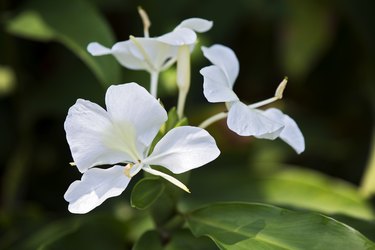
The Philippine camia plant or kamia (Hedychium coronarium and Hedychium philippinense) is called white ginger and butterfly ginger outside the Philippines and originated in tropical parts of Asia and India. Growing from rhizomes to 10 feet tall in its native lands, camia usually doesn't top 6 feet tall in U.S. Department of Agriculture plant hardiness zones 8 through 10, where it is hardy. Its hardiness range can extend at least as far north as USDA zone 7 when its rhizomes are protected by a heavy layer of mulch during winter.
Camia Flower Description
Video of the Day
Camia features 8- to 24-inch-long, lancelike leaves and 2- to 4-inch-wide, white flowers that resemble butterflies. Blotched with pale yellow at their centers, the fragrant white flowers appear in 4- to 12-inch clusters from pine cone-shaped buds at the top of camia's stems. Individual flowers are open for one day, though the plant continues blooming for about six weeks, usually from late summer through fall.
Video of the Day
Conditions for Blooms
Although camia can grow in a full-sun site, its foliage may appear bleached under those conditions. The plant needs at least four hours of sunlight per day to flower freely, however. The best solution, therefore, is to plant camia in partial shade and damp, humus-rich soil, spacing multiple plants about 2 to 3 feet apart. The horizontal rhizomes should be set just under the surface of the ground with their reddish shoots uppermost.
Camia Plant Care
Because arid conditions cue camia to enter dormancy, the plant's soil should never be allowed to dry completely during summer and should be kept as dry as possible during winter. Fertilize camia twice each year, in early spring and midsummer, spreading 1 cup of a chemical, granular, 13-13-13 fertilizer or 2 cups of an organic, granular, 5-5-5 fertilizer over the soil around each clump of camia shoots. Always water thoroughly after fertilizing.
Winter Protection of Camia
In areas colder than USDA zone 7, camia rhizomes generally are dug up in fall and stored indoors in barely damp peat, sawdust or vermiculite during winter. If you leave the rhizomes outdoors, cover them with a 4-inch-thick layer of dead leaves, composted manure, pine straw or other organic material after frost kills the camia foliage in fall.
If you dug your rhizomes for winter storage, wait until after the last spring frost to plant the camia outdoors again. Camia rhizomes left in the ground in winter don't always sprout in spring and may wait until early summer to make their appearance.
Alternately, plant camia in containers and take indoors when temperatures drop below 50 degrees Fahrenheit. Place the containers in a cool dry location where temperatures remain above freezing or in a greenhouse.
Uses of Camia Plants
While the camia plant benefits include the edible flowers and rhizomes, the main use in North American gardens is decorative. These lush plants add a tropical ambience to patios and courtyards. When planted in a tub, you can sink the plant into the moist soil surrounding a garden pond. The camia flower is the lovely blossom often added to leis in Hawaii and used as a cut flower elsewhere. In addition, the edible flowers are eaten in Thailand.